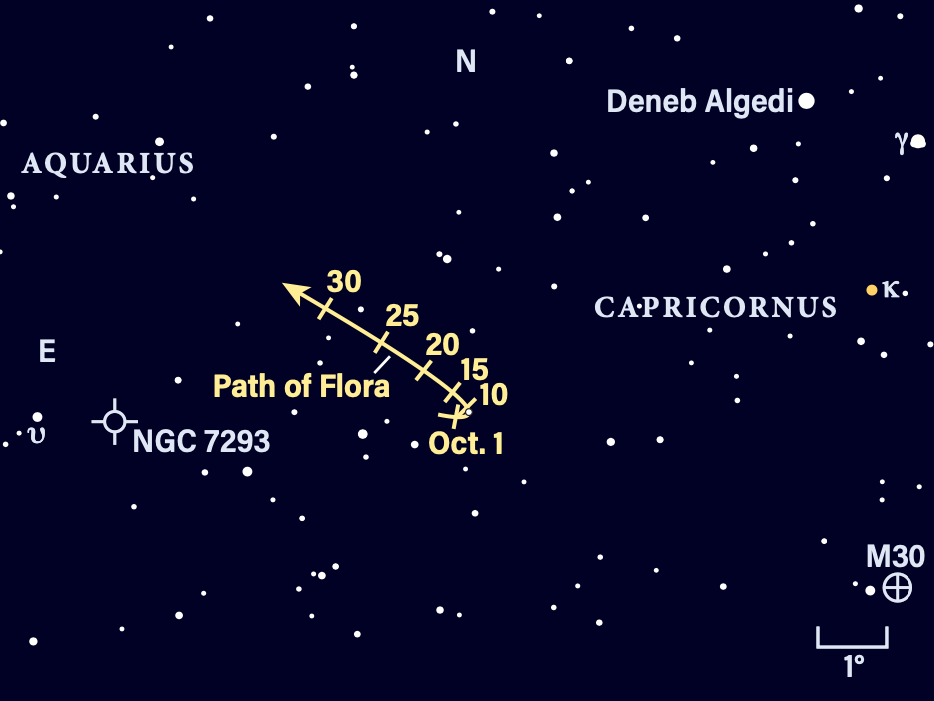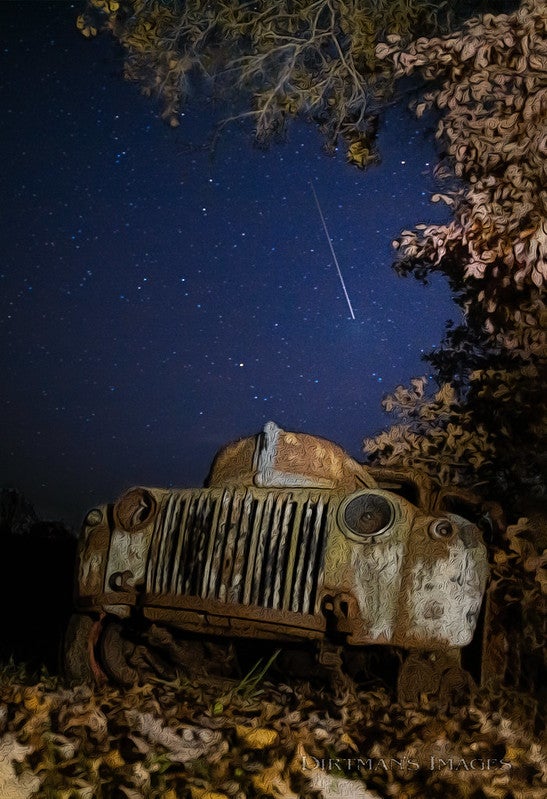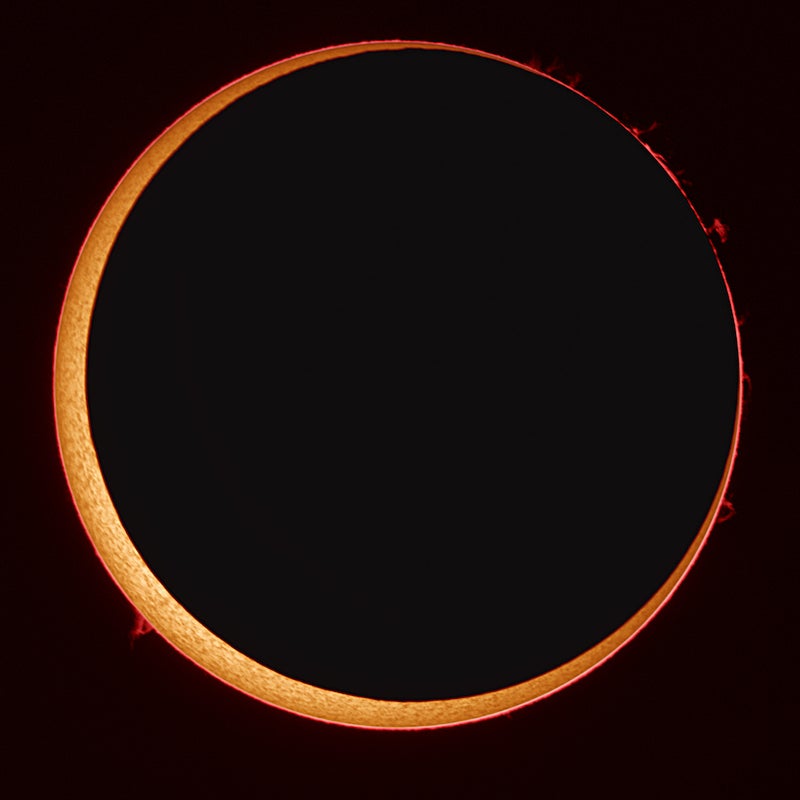
An annular eclipse of the Sun on Oct. 14 is the big event this month, with most of the U.S. seeing a partial eclipse. Saturn is stunning in the evenings, while Jupiter is nearing its best for the year, visible all night. And it’s a good time to track down Uranus and Neptune in binoculars. Venus dazzles in the morning sky, rising about four hours before the Sun. The second week of October is also a great time to view the zodiacal light.
Saturn is well placed all evening for observation with a telescope. It starts out at magnitude 0.5 and dips by 0.1 magnitude during October. The planet’s location in southwestern Aquarius adds luster to this dimly lit region of sky.
The ringed planet stands high in the south well before midnight. It sets by 4 a.m. on Oct. 1 and two hours earlier on Halloween. You’ll find Saturn 5° northeast of a waxing gibbous Moon overnight on Oct. 23/24.
Small telescopes readily show off the rings. Larger scopes reveal little more of the planet visually; details on the 18″-wide disk are best captured by using high-speed video and stacking the best frames.
Saturn’s ring system remains more than 41″ wide from its distance of over 9 astronomical units (837 million miles; 1 astronomical unit, or AU, is the average Earth-Sun distance). The current ring tilt is about 10°. The outer A ring is separated from the brighter B ring by the dark Cassini Division. The diaphanous inner C ring is lighter and partly transparent.
Saturn’s brightest moon is magnitude 8.5 Titan. It is north of the planet Oct. 9/10 and 25/26, and south Oct. 1/2 and 17/18. Some evenings, a star lies close to the planet, such as a 10th-magnitude field star Sept. 30/Oct. 1. It can be easily mistaken for a moon.
You will find three 10th-magnitude moons — Tethys, Dione, and Rhea — orbiting closer in than Titan. Their orbits lie in the plane of the rings and as the angle shrinks, transits of the planet’s disk occur. Tethys does this twice, once on Oct. 15/16 and again on the 17th. Tethys begins transiting shortly after 1:00 a.m. EDT on the 16th (still the 15th in western time zones), taking just over 70 minutes to cross the disk. Its tiny shadow follows within five minutes of the transit start, though you’ll need exceptional seeing conditions to view it. The sequence repeats Oct. 17 beginning around 10:20 p.m. EDT, with Tethys taking about the same amount of time to cross the disk. Note that these are approximate times; begin observing 15 to 20 minutes early. Recording video is better than visually trying to track the event.
Enceladus shines at 12th magnitude close to the edge of the disk. As the rings close over the next few years, this moon will become easier to spot as the glare from the rings diminishes.
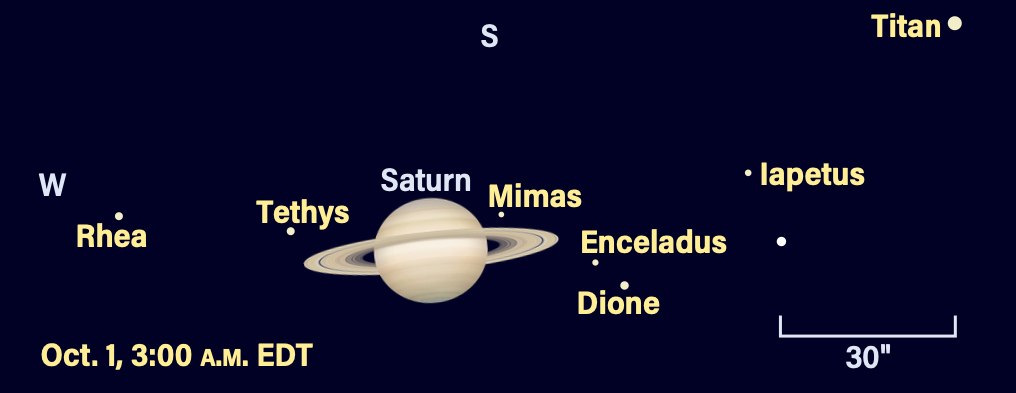
Iapetus is less than 1′ east of Saturn the morning of Oct. 1. It lies between Titan and Dione. The 10th-magnitude field star is a mere 15″ from Iapetus, making this a good night to spot the moon, glowing near 11th magnitude. Iapetus is racing toward eastern elongation on the 18th, dimming to 12th magnitude.
Neptune is visible all night in Pisces. It’s beyond the naked-eye limit, requiring binoculars or a telescope to spy. At magnitude 7.7, the distant world’s brilliance is similar to many other objects’, so it’s best to use brighter stars as a guide.
Magnitude 5.5 20 Piscium serves this purpose well. It’s westernmost in a line of three stars of similar brightness south of the Circlet of Pisces. Neptune stands 33′ west of 20 Psc on Oct. 1 and moves west each night. In mid-October, Neptune is very close to a magnitude 7.3 star, arriving just 6′ due north of it on the 15th.
Through a telescope, Neptune spans 2″ and glows bluish. It’s only a couple of weeks past opposition at the start of October, making this a great time to view the planet.
Jupiter is one month from opposition as October opens and rises just after 8 p.m. local daylight time. It’s gaining in diameter and brightness; by month’s end it’s reached a span of 49″ and a magnitude of –2.9, its most brilliant of the year.
Jupiter is located in southern Aries. On the 1st, the planet lies 3° south of a waning gibbous Moon.
Jupiter’s disk is packed with detail when seen through a telescope, though newcomers attempting their first view will find much of it subtle. Patient viewing aids in spotting fine details. The twin equatorial belts are the darkest features, along with the occasionally visible Great Red Spot.
The Galilean moons orbit every two to 17 days. In the runup to opposition, transits of the moons are preceded by their shadows with decreasing time separation. By early next month, both shadow and moon transit almost simultaneously. After opposition, the moon leads, followed by its shadow.
Check out the transit of Io Oct. 5, beginning with the moon’s shadow at 9:50 p.m. EDT, just as Ganymede is skimming the planet’s south pole. Io slips onto the disk shortly after 10:30 p.m. EDT. The shadow leaves the disk at midnight EDT, while Io follows 41 minutes later. On the 28th, Io’s shadow leads the moon by only nine minutes, starting at 10:02 p.m. EDT. Other transits with intermediate timing occur Oct. 12/13 and 21.
Ganymede performs a fine transit Oct. 12, prior to Io’s event the same evening. Starting at 9:56 p.m. EDT (not visible from Mountain and Pacific time zones), its huge black shadow crosses the planet’s southern polar region. Io’s shadow appears at 11:44 p.m. EDT, just as Ganymede’s shadow is leaving the southwestern limb. Io’s transit starts at 12:18 a.m. EDT on the 13th (Oct. 12 in all other U.S. time zones), followed 20 minutes later by Ganymede.
Europa transits the evenings of Oct. 2/3, 9/10, and 16/17, and early on the 24th. Each event starts progressively later in the night or early morning. Due to the moons’ inclined orbital plane relative to our line of sight, Callisto passes north or south of the disk this month.
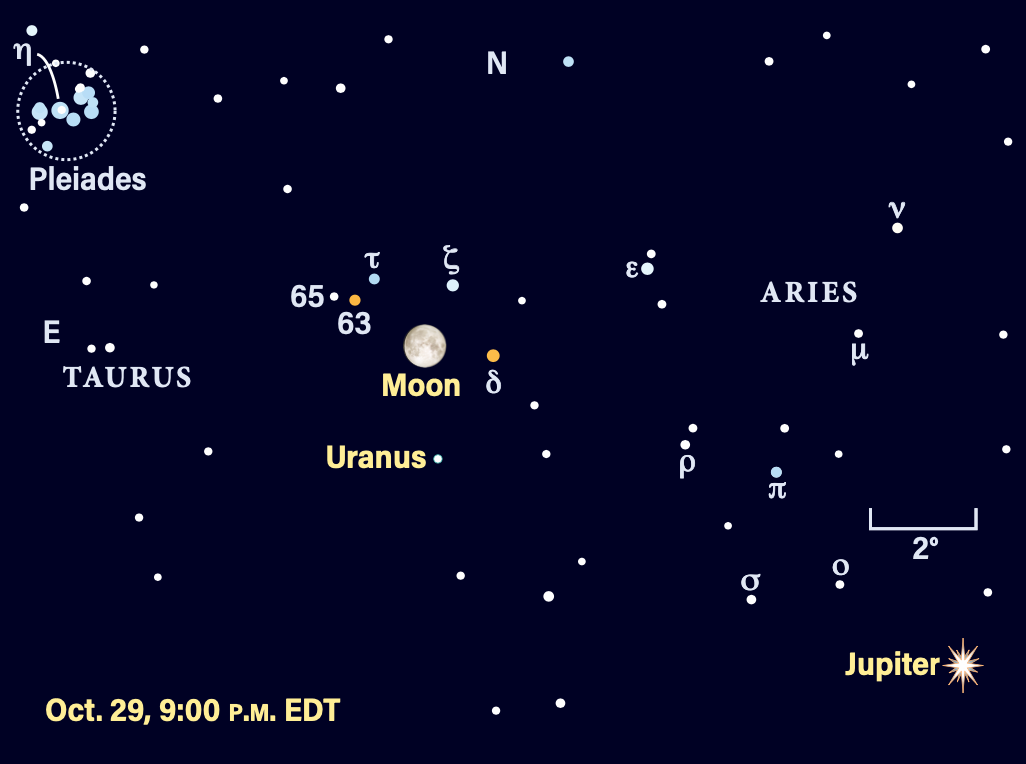
Uranus stands about 9° southwest of the Pleiades (M45) and 9° northeast of Jupiter. Scan the sky between Jupiter and M45 to find a small grouping of 5th-magnitude stars including Tau (τ) Arietis. Uranus is just over 3° south of this star. The planet glows at magnitude 5.7. Its bluish hue should stand out against the rest of the starfield.
Uranus moves westward as it approaches next month’s opposition, passing between a pair of widely spaced 7th-magnitude stars from the 16th to the 18th. By month’s end, Uranus lies 18.7 AU from Earth and is just 4″ wide through a telescope.
Early in the evening on the 29th, you’ll find Uranus about 2° south of the bright Moon. Our satellite moves eastward and later that night passes through a group of 5th- and 6th-magnitude stars, occulting two of them (63 and 65 Arietis) from some parts of the country.
Venus is a brilliant morning star, starting the month 7° west of Regulus, Leo’s brightest star. At magnitude –4.7, Venus is visible in the eastern sky soon after rising around 3:30 a.m. local daylight time. By the 10th, Venus is magnitude –4.6 and stands 2.5° south of Regulus. The pair is joined by a waning crescent Moon about 5° away.
Venus traverses southern Leo and on the 31st stands 6° northwest of Beta (β) Virginis. Through a telescope, Venus’ disk is a 32″-wide, 37-percent-lit crescent on the 1st. The disk shrinks to 22″ by the 31st and is 54 percent lit. Venus reaches western elongation (46°) on the 23rd. The planet is now 50 percent lit, called dichotomy. However, observers may see the actual moment of dichotomy occurring before or after this date. This is called Schröter’s effect, named for the German astronomer who first noted it, in 1793. At western elongations, dichotomy can be up to 6 days late. The phase is best determined in bright twilight.
Venus also acts as a nice guide for the line of the ecliptic if you want to observe the zodiacal light. For a few days around New Moon, check for this faint cone-shaped glow rising from the eastern horizon before morning twilight begins.
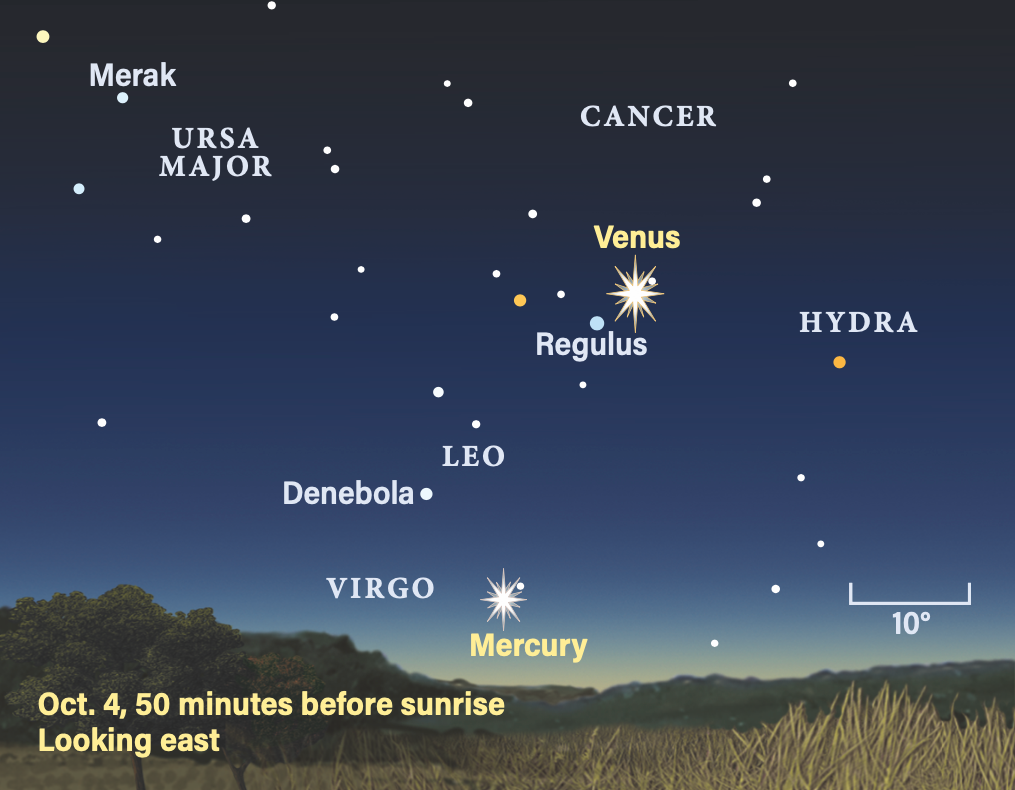
Mercury makes a brief morning appearance at magnitude –1.1 early in the month. Its elongation from the Sun is decreasing quickly. On the 1st, the planet stands 4° high in the east 50 minutes before sunrise. By the 4th, it has dropped to 2° high at the same time. Mercury reaches conjunction with the Sun Oct. 20 and returns to the evening sky later next month.
Mars is too close to the Sun for observation this month.
An annular eclipse of the Sun takes place Saturday, Oct. 14. Just six months before the much-anticipated 2024 total solar eclipse, it offers a great opportunity to practice observing that event. Most of the U.S. will see a partial eclipse with diminishing percentage farther from the central track. Only observers along that center line will see the annular eclipse.
The track of annularity, where the Moon crosses exactly in front of the Sun but leaves a brilliant ring at central eclipse — and subsequently always requires eclipse glasses to observe — runs from Oregon to Texas. Annularity begins near Eugene, Oregon, just before 9:17 a.m. PDT and ends in Texas near Corpus Christi around 12:01 p.m. CDT.
The eclipse continues through Mexico, Belize, Honduras, Nicaragua, and Panama. It then enters Colombia and begins to turn eastward across Brazil. The path enters the Atlantic Ocean south of Natal, where the Sun sets during the final partial phase.
Two weeks after the annular eclipse, a partial eclipse of the Moon occurs Oct. 28, visible in Europe, Africa, India, and Asia. Observers in the northeastern U.S. might see the Full Moon rise with a dusky southern edge, the result of the final stages of the penumbral eclipse.
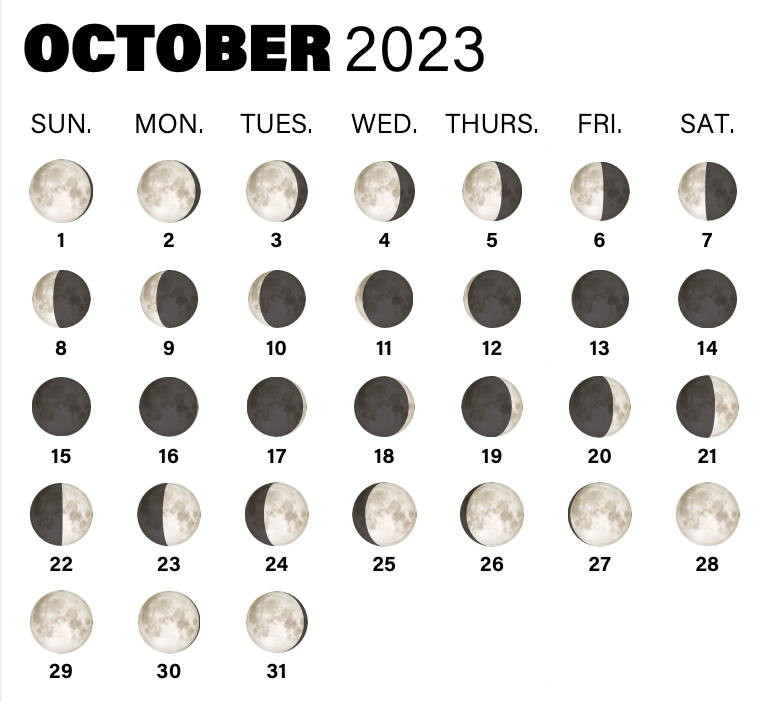
Rising Moon: One glorious sight after another

The waxing crescent Moon rides low in the autumnal evening sky yet sports a magnificent array of wonders along the light-dark terminator that make it worthwhile to watch each night.
On the 21st, the rugged lunar Apennines thrust diagonally into the sunlit domain near the lunar equator. Lying to their north along the terminator are two young craters — Autolycus and Aristillus — sticking up proudly above the lower plains. They formed a couple of billion years ago near the end of the last major lunar bombardment. The low Sun angle highlights the rugged apron of debris that splattered around each circular formation, while their steep, high walls prevent this light from reaching much of the floors. Stay for an hour on nearby fabulous Archimedes and watch the long shadows stretching into the terminator retreat as the rotation of the Moon causes the Sun to rise.
Consider the characteristics of these “youthful” craters. The larger impactor that created Aristillus was able to excavate a lot more material — there are many more streaks and ridges pointing radially away from this crater than Autolycus. Also compare the rims and aprons to those of the large, round craters Hipparchus and Albategnius south of the equator. Evidence of the latter’s greater age comes from their degraded features, the result of incessant pounding from smaller impacts over time. Their central peaks are lower, their walls are rounded and pockmarked with dozens of craterlets, and their aprons have been smoothed out.
Return on the 22nd to see how the higher Sun angle begins to conceal the aprons’ roughness. You may also notice the appearance of the Straight Wall located in the southern third of the Moon.
Meteor Watch: What Halley leaves behind
The peak of the Orionid meteor shower coincides nicely with a First Quarter Moon this year. After the September lull, observers look forward to the Orionids in part because they are produced from debris shed during historic passes of the famous Halley’s Comet. The Orionids could reach a zenithal hourly rate of 20 to 30 meteors per hour overnight on Oct. 21/22, the night of maximum, corresponding to an observable rate of 15 to 20 per hour between 2 a.m. and dawn as the radiant in northeastern Orion rises higher in the sky.
The shower is active from Oct. 2 through Nov. 7, and rates away from the maximum are much lower. The radiant rises by 11 p.m. local daylight time. As with all meteor showers, the best observing time is in the early morning, when you are on the leading side of Earth and heading directly into the meteor stream.
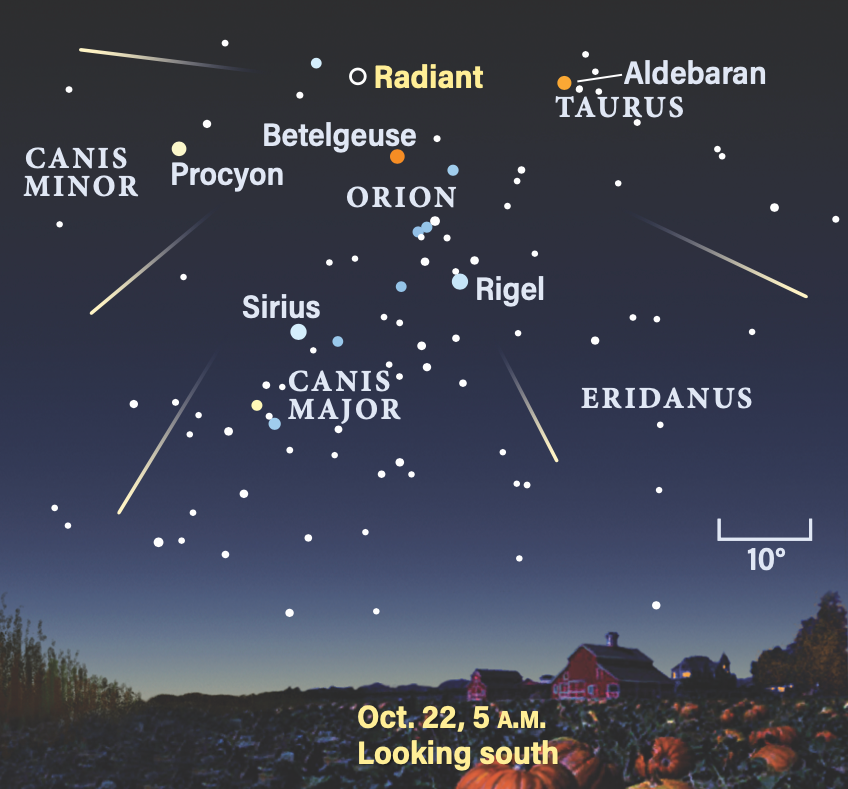
Comet Search: The clown with green hair
Peaking at 8th magnitude, Comet 103P/Hartley (also called Hartley 2) will be a decent telescopic sight after midnight from country skies with a 4-inch scope. Binoculars may pull it in, too. From the suburbs, it’s in range of a 10-inch scope.
Although Hartley 2 passed closest to Earth last month, it is still closing in on the Sun for perihelion on the 12th. The mile-long, bowling-pin-shaped dirty snowball orbits Sol every 6.48 years. We get a good chance at it every 12.96 years, but that slight shortfall in time means that for each return, Earth arrives later so the comet is farther and fainter. Next month is our last view brighter than 10th magnitude for a few decades.
We do get a consolation prize: On the 12th and 13th, the “hairy star” is only 0.5° from NGC 2392 in Gemini, sometimes called the Lion or the Clown-faced nebula. To imagers, both will be green. The higher surface brightness of the planetary nebula will trigger our green cone receptors through 10-inch scopes, but visually the comet’s fuzz will remain ashen gray. We are seeing the comet almost head-on. Can you notice which side is out of round?
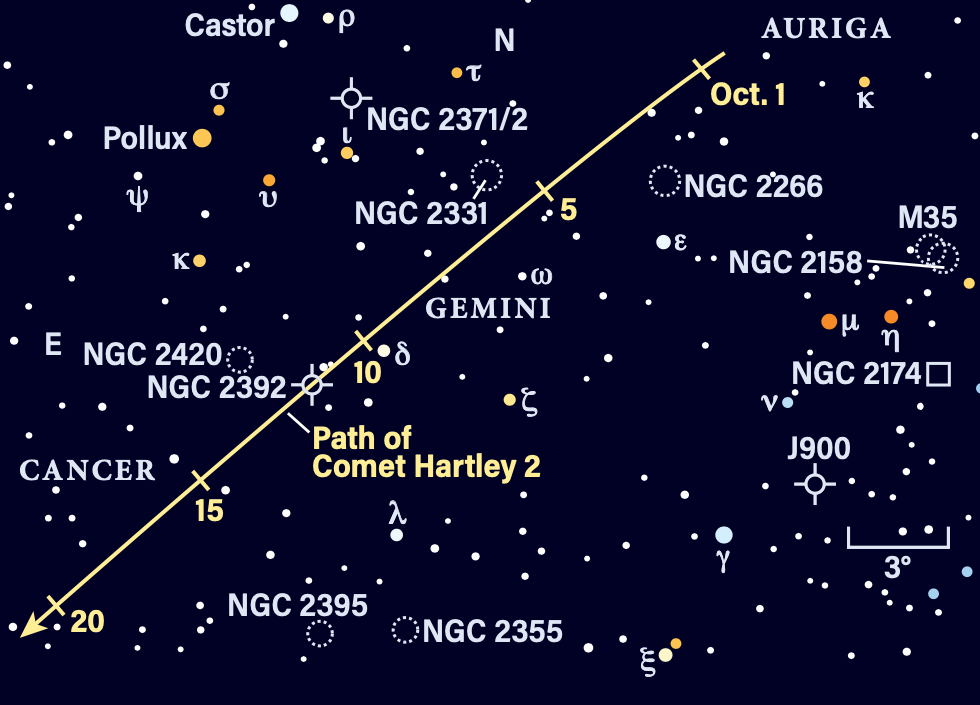
Locating Asteroids: A drop in the water
Can you move your scope straight up and down? That’s all it takes to locate the large asteroid 8 Flora this month. Just before 10 p.m. local daylight time, Saturn and Iota (ι) Aquarii cross the meridian, the imaginary line rising overhead from the southern horizon. Shift the view 7° directly down to land on Flora. If you don’t know your exact field of view, there are online calculators for any scope-eyepiece combination.
Use the chart to keep tabs on the patterns of triangles, voids, and clumps as you near the spot. On the 7th and 8th, Flora forms a tight pair with a magnitude 7.4 field star. The 85-mile-wide, nearly spherical mountain will be notably fainter at magnitude 9.2. You likely won’t see any movement during your observing session because Flora is just exiting a hairpin retrograde arc, its motion briefly parallel to Earth’s. Take a break from Oct. 22 to 25, when the passing waxing gibbous Moon throws out its veil of light.
Flora was discovered by Englishman John Hind in 1847, decades after Giuseppe Piazzi had pegged 1 Ceres in 1801.
